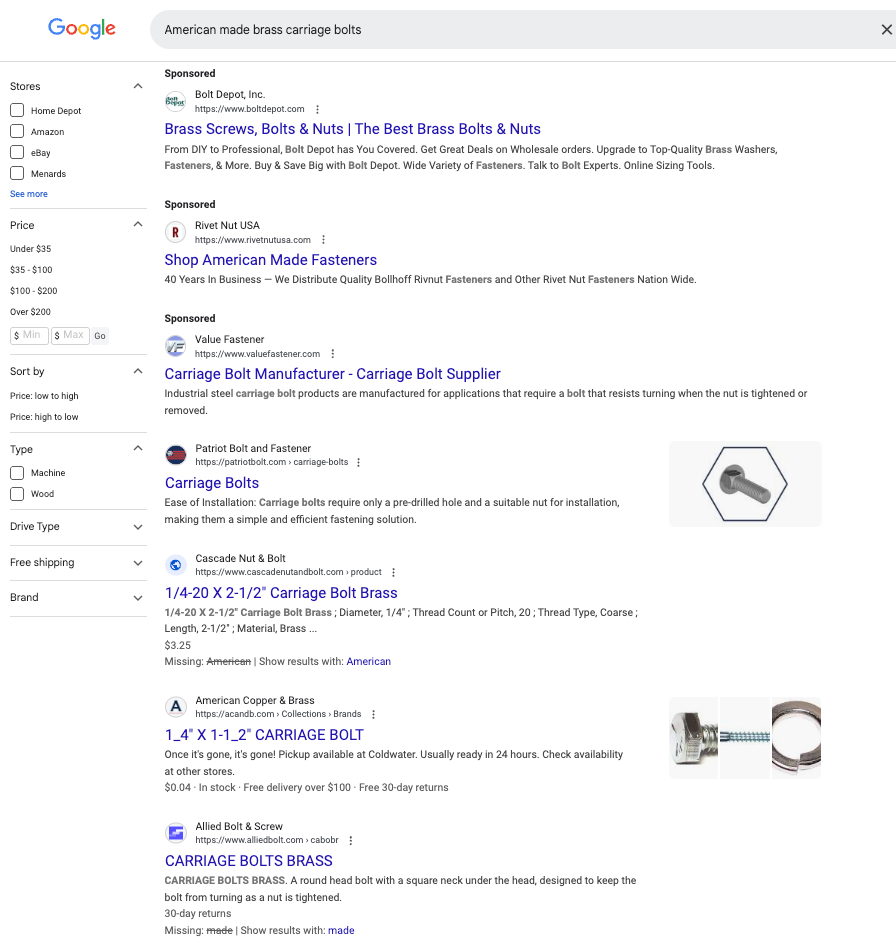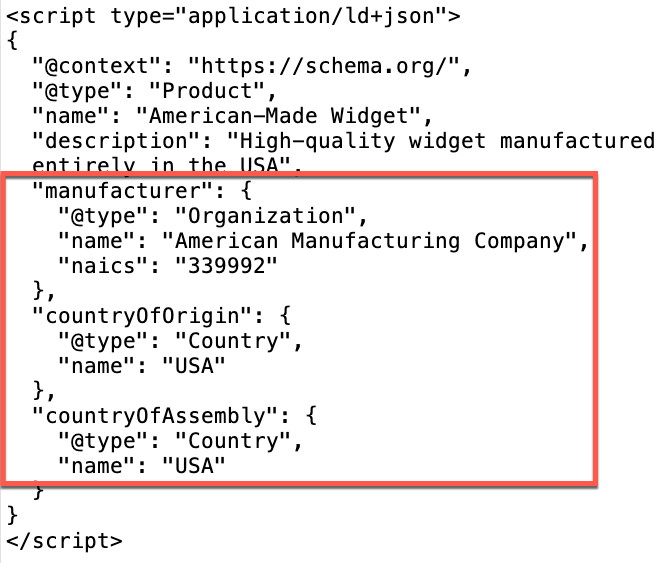In today’s turbulent trade environment, a significant disconnect is costing American manufacturers dearly. While tariffs on imported goods have surged, many U.S.-based suppliers remain largely invisible to buyers actively seeking domestic alternatives.
This article was inspired by a national news story about furniture makers in the U.S. whose products are largely domestically sourced—except for one key category: assembly hardware. Curious whether we still manufacture fasteners like brass carriage bolts domestically, I checked under my kitchen table and ran a simple Google search: “American-made brass carriage bolts.” The results were discouraging. While there were many listings, only one indicated U.S. manufacturing on the first page.

That’s when the deeper problem came into focus: U.S. manufacturers have not made themselves discoverable online—especially in ways that align with how procurement professionals search.
The Root Causes of Digital Invisibility
Outdated or Nonexistent SEO & Schema Implementation
First, many long-established domestic manufacturers lack digital marketing sophistication—particularly when it comes to structured data and modern search engine optimization techniques. These elements are essential to being discovered as viable “Made in USA” alternatives. Many long-standing U.S. manufacturers lack modern digital marketing practices. In a quick audit of a dozen websites across three categories, I found that most didn’t even mention they were made in the U.S., and only one website used Schema tags to clearly communicate this to search engines.
2. Misaligned Messaging for the Moment
The second critical issue facing American manufacturers goes beyond mere visibility to a fundamental misalignment in messaging. With this unprecedented opportunity to capture demand from companies actively seeking immediate supply chain solutions, many U.S. manufacturers have not updated their messaging. They fail to highlight the unique comparative value they offer in this new tariff-driven landscape. When a 10% tariff is applied to all imported goods and 145% on those from China, previously uncompetitive domestic options suddenly become economically viable, yet manufacturers rarely quantify or highlight this new economic reality in their marketing.
According to a recent CNBC Supply Chain Survey (April 2025), 74% of companies cited costs as the main reason for their reluctance to reshore manufacturing to the U.S. This presents both a challenge and an opportunity: U.S.-based suppliers need to proactively message not just “Made in America,” pride, but their ability to deliver competitive costs—whether through advanced automation, lean production, or supply chain efficiencies. Beyond price, companies should emphasize non-financial benefits, such as reduced geopolitical risk, insulation from sudden tariff fluctuations, and faster, more reliable delivery times. With governments frequently wavering on tariff policies, buyers crave stability; smart messaging should position U.S. suppliers as resilient and lower-risk partners.
While buyers are urgently seeking alternatives to avoid high tariffs, few manufacturers are positioning themselves to capitalize on this moment. They’ve failed to update their messaging to emphasize their competitive value—tariff-free, shorter lead times, supply chain resilience, and American quality.
3. Search Terminology Disconnect
Third, there’s a terminology mismatch. Buyers searching for alternatives rarely use the same language manufacturers use to describe their products. Procurement professionals often search for terms like “domestic supplier,” “U.S. origin,” or shipping phrases such as “FOB origin.” In contrast, manufacturers tend to rely on emotional or branding-driven language, such as “Proudly American Made,” “Made in Detroit,” or even vague phrases like “Made in the Heart of America,” as seen on Weber Grills’ website, which mentions U.S. production with multiple “Americcan-made” slogans and inferences. These may resonate in a commercial or branding context, but they often fail to register with search engines as clear geographic indicators, let alone American-made.
I found several companies with “USA” in their name and flag-heavy designs on their websites, yet with no actual mention of manufacturing location. If you don’t say it clearly and consistently—search engines won’t infer it. And if buyers can’t find you, they’ll continue looking elsewhere.
Procurement professionals search using terms like:
- “Domestic supplier”
- “US origin”
- “Tariff-free sourcing”
Meanwhile, U.S. manufacturers use language like:
- “Proudly American Made”
- “Made in the Heart of America”
These patriotic phrases are great for branding but often go unrecognized by search engines as geographic indicators. Even sites with “USA” in their domain and red-white-blue color schemes frequently fail actually to say they manufacture in the U.S.—and if you don’t say it, Google won’t infer it.
The Real Cost of Being Hard to Find
As companies scramble to absorb rising import costs and struggle to find domestic alternatives, they turn instead to lower-tariff countries. This creates a lose-lose scenario: U.S. manufacturers miss out on urgently needed contracts, and procurement professionals face longer lead times, logistical uncertainty, and offshore complexities. The opportunity is slipping away—not because the products don’t exist, but because the suppliers are invisible in search results.
To change this, U.S. manufacturers must urgently address their digital presence. What follows are specific and practical website enhancements that can dramatically improve visibility and positioning in this competitive environment.
How to Make Your Products Discoverable
Here are concrete actions to transform your visibility:
Product Page Updates
Product pages serve a dual purpose. They must have strong signals to enable them to be found and ranked in search engines. Product and category pages are also a crucial place to emphasize that your goods are American-made. Add a “Made in USA” message to your page title tags, headers, product descriptions, and Schema.
- Title Tags & Headers: Include “Made in USA” and relevant product terms.
- Example:
<title>Brass Carriage Bolts - Made in USA - Tariff-Free Shipping</title> - Relevant headings – American-Made Quality Since 1985
- Example:
- Descriptions: Integrate Made in the USA to meta descriptions and product copy.
Don’t just say it in the text. You must also visually reinforce it. Create a “Made in USA” badge or icon and place it near the product image or price. Name the file something meaningful like made-in-usa.jpg, and be sure to add descriptive alt text. These small cues add contextual clarity for search engines.
Where appropriate, add short contextual descriptions of your U.S. manufacturing process. If it fits naturally into your page template, this could be a line that highlights location, craftsmanship, or domestic sourcing. You can also reinforce the message by adding a line to the footer—e.g., “Proudly manufactured in the USA since 1995.”
For added technical clarity, include manufacturer and origin Schema markup to existing product schema to indicate the country of origin and assembly. For example:

Homepage Changes
Your homepage should immediately reinforce your domestic identity. Include “American Made” or “Made in USA” prominently in headlines, bolded text, or callouts. If possible, mention your state and any regional strengths. Don’t sacrifice storytelling for SEO—but ensure the connection is unmistakable.
You should also enhance your homepage or “About Us” section with Organization Schema, including relevant NAICS codes and geographic details. For example, if you manufacture fasteners:
- Make “Made in USA” prominent in headlines and body content.
- Add Organization schema using NAICS codes.
- Clarify location and manufacturing status—don’t assume branding implies origin.
Manufacturers should also enhance your homepage or “About Us” page with Organization Schema to include relevant NAICS codes and geographic details. For example, if you manufacture fasteners, you should add the industry code and description:

About & Manufacturing Pages
If you don’t already have a dedicated page for your American manufacturing story, now is the time to build one. Showcase your factory, employees, and processes. Specify the origin of your materials and describe the process of their assembly. Include certifications, association memberships, and relevant industry codes (e.g., NAICS, Harmonized Tariff Schedule codes). This adds credibility and improves your site’s authority.
Consider adding a visual trust badge signifying “Made in the USA.” Again, name the file clearly and use descriptive alt text to help search engines and users alike connect the dots. Trust badges have been shown to build confidence and increase conversions by demonstrating trustworthiness or safety. While there is no official “Made in USA” badge similar to the USDA’s certified organic badge, you can license one or create your own.
Tariff-Specific Landing Pages
Create one or more landing pages that are explicitly focused on helping buyers avoid tariffs. Use procurement-specific language such as “domestic sourcing,” “tariff-free manufacturing,” or “U.S. alternative to Chinese [product].”
Highlight the practical business advantages:
- Total landed cost comparisons with and without tariffs
- Supply chain reliability and reduced shipping costs
- Faster lead times and ease of doing business
- A calculator to show real-time cost impacts if possible
Also, consider sector-specific landing pages:
“U.S. Alternative to Chinese Injection Molding”
“Made in USA Screws for Automotive OEMs”
“Tariff-Free [HS Code] Manufacturer”
As time passes, generate case studies to demonstrate how you helped new customers mitigate the impact of tariffs.
Overcoming the Cost Objection
Add messaging that counters the argument that Made in America is more expensive by emphasizing total value, risk reduction, and resilience and promoting the broader business advantages of buying American. This includes:
- Risk mitigation: Protecting buyers from sudden tariff hikes, import restrictions, and global shocks.
- Supply chain agility: Offering shorter lead times, local inventory, and faster response to demand changes.
- Total cost of ownership (TCO): Reducing hidden costs like freight, duties, customs delays, and inventory carrying.
- Reputation and trust: Strengthening customer trust by sourcing domestically.
Example Messaging to Encourage “Buy American” Decisions
- “While our unit prices may be slightly higher, our customers save significantly when you factor in freight, tariffs, and reduced downtime.”
- “We help you avoid the unpredictable swings of global markets by offering a stable, local supply chain you can rely on.”
- “With American-made products, you’re investing in quality, compliance, and long-term resilience—not just short-term cost savings.”
- “Partnering locally means faster delivery, quicker adaptation to your needs, and protection from future global disruptions.”
By framing reshoring and local sourcing as a strategic investment, not just a line-item expense, U.S. suppliers can appeal to the growing number of buyers looking to de-risk and future-proof their operations.
Update Paid Search Campaigns
Of all the ads I encountered during my searches, only one mentioned U.S. manufacturing. That’s a major miss. Adjust your ad copy and keywords to match the specific buyer’s search intent.
Some examples:
“Made in USA Screws for Medical Equipment”
“USA-made [product] for OEMs”
“Tariff-safe [component]”
“Domestic suppliers [HS code]”
Get Found in Industry Directories
Ensure your company is listed on major manufacturing directories and that each listing indicates U.S. manufacturing or assembly capabilities.:
7. Media Monitoring
Every day, companies are mentioned in news articles as struggling with tariffs. Set up Google Alerts and use AI agents like Perplexity to monitor keywords, industries, and buyer behavior. Identify opportunities to connect with buyers facing the exact problem your products solve.
Taking Action: The Time Is Now
The disconnect between American manufacturers and procurement professionals represents one of the most significant missed opportunities in today’s tariff-driven economy. While buyers search for solutions, U.S. manufacturers with the exact products they need often remain hidden—sometimes due to as simple as unstructured content or vague messaging.
The economic consequences extend well beyond individual businesses. Each week that passes without action results in revenue lost to overseas competitors, missed contracts, and a failure to capitalize on a moment that favors American-made goods.
Need Help? That’s What We Do
Don’t let your American-made products go undiscovered. Bisan Digital specializes in helping manufacturers bridge this exact gap. We implement the technical and content strategies outlined here, ensuring that your “Made in USA’ products appear where procurement professionals are looking.
Contact Bisan Digital today for a comprehensive review and a customized digital visibility plan. Let’s ensure your American craftsmanship is recognized, valued, and chosen.
